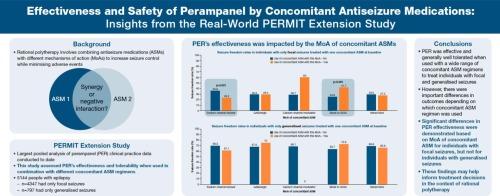Effectiveness and safety of perampanel by concomitant antiseizure medications: Insights from the real-world PERMIT Extension study
IF 2.3
3区 医学
Q2 BEHAVIORAL SCIENCES
引用次数: 0
Abstract
The PERMIT Extension study is the largest pooled analysis of perampanel (PER) clinical practice data to date. A post-hoc analysis of PERMIT Extension assessed the effectiveness and tolerability of PER with different concomitant antiseizure medication (ASM) regimens. Effectiveness was assessed by evaluating responder and seizure freedom rates at the last observation for each participant (‘last visit’), and tolerability was assessed by evaluating adverse events. The analysis included 5144 people with epilepsy who had only focal (n = 4347) or only generalised (n = 797) seizures when PER was initiated, and whose type of concomitant ASM regimen at that time was known. Effectiveness and tolerability varied considerably depending on the pharmacology and mechanism of action (MoA) of concomitant ASM regimens. For example, in individuals with focal seizures receiving only one concomitant ASM at baseline, seizure freedom rates were significantly higher if the concomitant ASM was one that binds to synaptic vesicle glycoprotein 2A (SV2A) versus one that does not bind to SV2A (41.7 % vs. 24.8 %; p < 0.001), and significantly lower if the concomitant ASM was a sodium channel blocker versus a non-sodium channel blocker (23.2 % vs. 35.6 %; p < 0.001); whereas, in those with generalised seizures receiving one concomitant ASM at baseline, there were no significant differences in seizure freedom rates according to the concomitant ASM’s MoA. In individuals with focal and generalised seizures, tolerability appeared to be less affected by the pharmacology and MoA of concomitant ASM regimens. The findings from this study may help inform the use of rational polytherapy in clinical practice.

perampanel联合抗癫痫药物的有效性和安全性:来自真实世界许可扩展研究的见解
许可扩展研究是迄今为止最大的perampanel (PER)临床实践数据汇总分析。一项对许可延期的事后分析评估了PER与不同伴随抗癫痫药物(ASM)方案的有效性和耐受性。通过评估每个参与者在最后一次观察(“最后一次访问”)时的应答率和癫痫发作自由率来评估有效性,通过评估不良事件来评估耐受性。该分析包括5144例癫痫患者,他们在PER开始时只有局灶性(n = 4347)或只有全身性(n = 797)癫痫发作,并且当时已知其伴随的ASM方案类型。有效性和耐受性根据伴随的ASM方案的药理学和作用机制(MoA)而有很大差异。例如,在基线时仅伴有一种急性发作的个体中,如果伴有一种与突触囊泡糖蛋白2A (SV2A)结合的急性发作自由率显著高于不与SV2A结合的急性发作自由率(41.7% vs 24.8%; p < 0.001),如果伴有一种钠通道阻滞剂而非钠通道阻滞剂(23.2% vs 35.6%; p < 0.001);然而,在那些在基线时接受一次伴发ASM的全身性癫痫发作患者中,根据伴发ASM的MoA,癫痫发作自由率没有显著差异。在局灶性和全身性癫痫发作的个体中,耐受性似乎受伴随的ASM方案的药理学和MoA的影响较小。本研究结果可能有助于在临床实践中合理使用综合疗法。
本文章由计算机程序翻译,如有差异,请以英文原文为准。
求助全文
约1分钟内获得全文
求助全文
来源期刊

Epilepsy & Behavior
医学-行为科学
CiteScore
5.40
自引率
15.40%
发文量
385
审稿时长
43 days
期刊介绍:
Epilepsy & Behavior is the fastest-growing international journal uniquely devoted to the rapid dissemination of the most current information available on the behavioral aspects of seizures and epilepsy.
Epilepsy & Behavior presents original peer-reviewed articles based on laboratory and clinical research. Topics are drawn from a variety of fields, including clinical neurology, neurosurgery, neuropsychiatry, neuropsychology, neurophysiology, neuropharmacology, and neuroimaging.
From September 2012 Epilepsy & Behavior stopped accepting Case Reports for publication in the journal. From this date authors who submit to Epilepsy & Behavior will be offered a transfer or asked to resubmit their Case Reports to its new sister journal, Epilepsy & Behavior Case Reports.
 求助内容:
求助内容: 应助结果提醒方式:
应助结果提醒方式:


